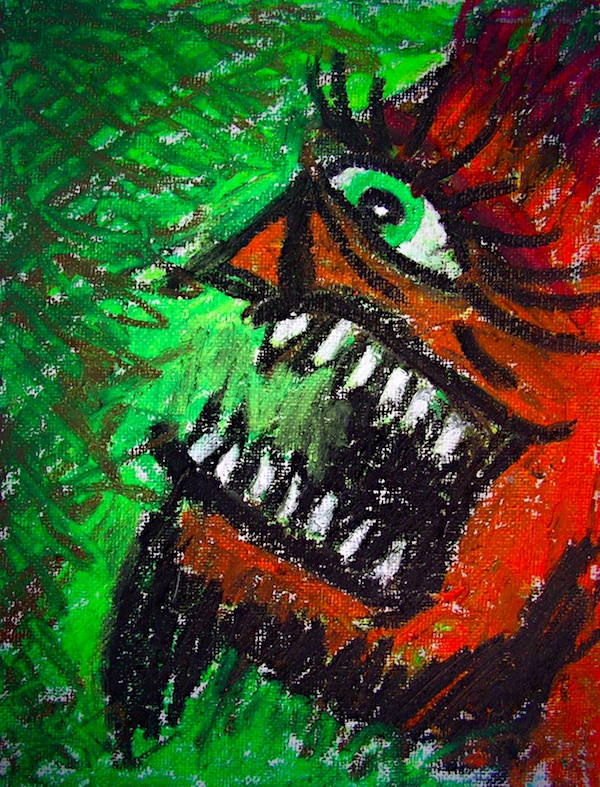
Image courtesy Amber
Much of the recent discussion of the ‘Grease Yaka’ in the Sinhala and English language media or ‘Mystery Man’ as it is referred to in Tamil discourse has been concerned with the origins or ‘truth’ behind the incidents, reports and rumours that have gripped the island. I wonder if the heated debates on the matter, which spill off the pages into the conversations in our communities, are rather missing the point of this rather slippery Bogeyman – and indeed the best means of responding to it.
A Moving Target
Without obscuring or denying the actual violence of attacks and counter attacks, it seems that the most interesting characteristic of the figure of the ‘Grease Yaka/Mystery Man’ is its ability to embody the fears and preoccupations of diverse communities across the country. Even though there are certain general features (ie. the targetting of women, the cuts/scratches to hands or breasts, and the elusive nature of the perpetrators) that appear in reports from across the country, the ‘Grease Yaka/Mystery Man’ seems to take on localized qualities in each community where it is manifest.
Where there are concerns about militarization the Bogeyman is thought to be an army operative or deserter, for those who mistrust institutions charged with maintaining law and order it seems the police are freeing captured suspects, and worries about the implications of deepening Sino-Lanka ties lead others to speculate that the “Grease Yaka/Mystery Man’ is Chinese or using superior imported technology to elude capture. For those troubled by the entrenchment of the current regime the figure is an attempt to remain in power, either by means of blood sacrifice or by the more mundane (but no less feared) continuation of the state of emergency. Minority groups that already feel oppressed now believe that they are being especially targetted. Those supportive of the current regime perceive an unseen hand of opposition parties, foreign governments or an Eelamist disapora behind the incidents or stories.
So perhaps one reason for the runaway success of this particular Bogeyman is that it has something for everyone. Another may be that there is a kernel of truth in many of the fantastic stories that circulate – the practice of household intruders oiling their bodies is widely accepted; in post-war communities there are men from the intelligence services moving about in civvies; women do experience fears of sexual violence; police do sometimes refuse to record complaints due to political influence; there have been instances of violence against women – some extremely serious. A third contributing factor may simply be that these sorts of stories spread like wildfire in Sri Lanka – one has only to recall the panic around reports that ‘the Tigers are coming’ in the early 80s for a potent example of this.
Whatever the origins of the ‘Grease Yaka/Mystery Man’ were, and whomever was responsible for its origins, this new Bogeyman surely now has a life of its own – evolving rapidly into novel forms, being used to account for a wide range of events both current and past, and provoking strong reactions that may surpass the original attacks in their severity and further escalate the crisis.
Responding to the Bogeyman
The reactions to the ‘Grease Yaka/Mystery Man’ by communities and the State have largely led to increased violence and tension. Vigilance groups have assaulted suspects, damaged property and taken lives. The armed forces have responded with lethal force against protesting mobs, but also have beaten scared villagers and threatened community leaders in their attempts to quell fears – with quite the opposite effect. Irresponsible coverage by media and analysts about ‘Grease Yaka/Mystery Man’ attacks and unsubstantiated speculation about who stands to benefit from the widespread panic (ie. the regime, the military, opposition parties, anti-state groups) has increased mistrust across fault-lines and fuelled the intemperate responses. Political actors on all sides have shamelessly sought to exploit the situation, even as they lay blame at the feet of their opponents. All of the above share a degree of responsibility for the blood that has been shed and the climate of fear that has been created.
A few laudable low-key examples of responsible actions in the face of the current crisis come from within affected communities themselves. In one region, there have been attempts to find non-violent ways of providing security to frightened communities – with a voluntary association suggesting that young men play roadside cricket until 11pm, rather than roam the streets armed with sticks on the lookout for prowlers. A few women in a village where a recent ‘Grease Yaka/Mystery Man’ incident took place now make it a point to leave their front-doors wide open and their porch lights on until late in the evening, to actively avoid feeding the fear that causes their neighbors to barricade themselves in their homes after dark. In one district, some community members have begun to visit the homes of reported victims, after the inevitable brouhaha has died down, to try and determine what precisely took place in each instance – in order to respond responsibly to rumours and to individual cases of violence against women.
The people above, who are living with the consequences of the panic and violence stoked by irresponsible reactions to the ‘Grease Yaka/Mystery Man’ phenomenon, understand that the real danger presented by a Bogeyman is its ability to provoke responses driven by fear and hysteria. The insight that those who attempt to catch the ‘Grease Yaka/Mystery Man’ tragically miss, and those who engage in the inflammatory discourse of blame and accusation perhaps cynically overlook, is that at times like these what we must defend ourselves most vigorously from is fear itself.